Wondering how much radiation a hazmat suit can withstand? This is an important question for anyone who needs protection in hazardous environments.
Hazmat suits can reduce exposure to lower-level radiations, but they do not offer complete immunity against all types of radiation. Their effectiveness depends on the material and design of the suit.
Read on to explore the details of hazmat suits. We’ll look at the different types of suits, how they protect against radiation, and their limitations. Plus, we’ll discuss how to choose the right suit for your safety needs.
Understanding Radiation and Hazmat Suits
When it comes to understanding how much radiation a hazmat suit can withstand, it’s crucial to recognize that not all suits are created equal in their protective capabilities. As we delve into this topic, we’ll explore the various types of radiation and how hazmat suits are designed to offer protection, balancing practicality with safety.
To start, here’s a video showing a hazmat suit demonstration:

How Hazmat Suits Protect Against Different Radiation Types
Hazmat suits are designed to protect you from various types of radiation, though their effectiveness varies depending on the radiation form. They primarily shield you from radioactive particles and energy waves, which are common in environments like nuclear reactors or in the aftermath of an atomic bomb blast.
However, it’s important to remember that these suits are not foolproof against all forms of radiation, especially ionizing types found in nuclear accidents and X-rays. Despite this, they offer significant protection and are a critical component of safety protocols in hazardous environments.
In terms of radiation types, there are two primary concerns: irradiation and contamination.
Irradiation refers to absorbing radiation from your environment, while contamination occurs when your body comes into direct contact with radioactive particles.
This is where hazmat suits come in, providing a barrier against these harmful particles, especially when equipped with air filters vital for preventing inhalation of radioactive materials.
Evaluating the Radiation Shielding Properties of Hazmat Suits
The efficacy of a hazmat suit in shielding against radiation depends heavily on its construction and the specific materials used. The highest level of protection is offered by fully encapsulated suits, often combined with a self-contained breathing apparatus (SCBA).
These suits are designed to minimize exposure, even though they cannot completely eliminate the risk of ionizing radiation. They are particularly effective against lower levels of everyday radiation, ensuring that radioactive isotopes do not come into direct contact with the skin or enter the body through inhalation.
Additionally, the inclusion of metal shielding and high-quality air filtration plays a significant role in reducing radiation exposure. Materials like lead or iridium are commonly used for their radiation-blocking properties. However, it’s essential to understand that while these suits offer substantial protection, they are not invincible against all levels of radiation, particularly high-energy, highly penetrating forms.
Debunking Myths: The Reality of Radiation Protection in Hazmat Suits
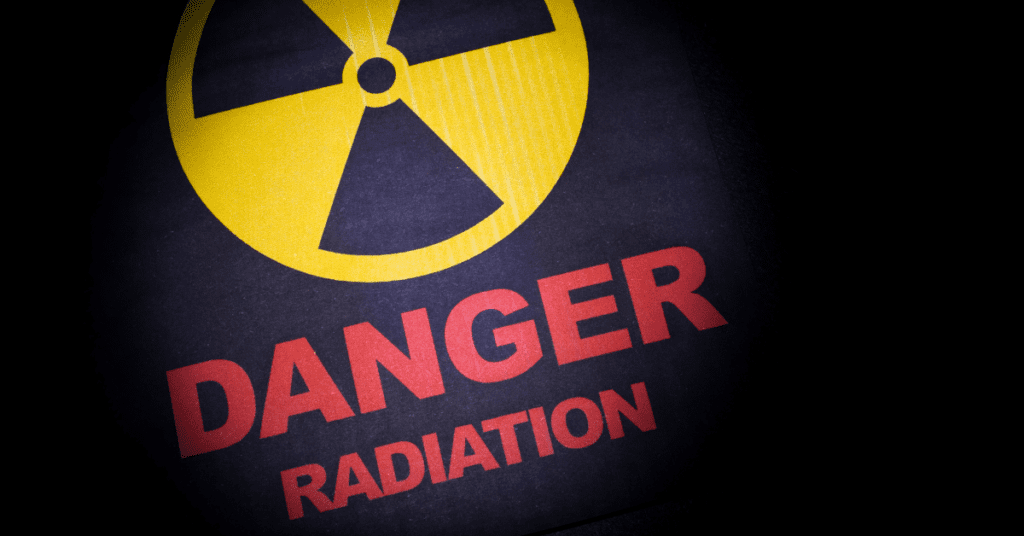
Contrary to some misconceptions, no hazmat suit is entirely “radiation-proof.” While they are invaluable in providing a barrier against radioactive particles, these suits cannot fully shield you from all forms of ionizing radiation, particularly those associated with high levels of exposure like in nuclear reactor cores or X-ray machines.
Certified Fire and Workplace Safety expert Nick Klamecki explains:
“No, hazmat suits are not radiation proof against ionizing radiation found in nuclear accidents and x-rays. However, the highest level fully encapsulated hazmat suits (A, B) can protect the wearer from some radiation during short periods of exposure. You want to be very wary of being near ionizing radiation without protective gear, and try to minimize the time spent near it. Low-level everyday radiation is generally harmless and a hazmat can protect the wearer from these.”
This understanding is critical, especially for individuals working in high-risk environments, as it underscores the importance of using these suits as part of a broader safety strategy rather than a sole line of defense.
Types of Hazmat Suits and Their Radiation Protection Capabilities
Understanding the various levels of hazmat suits is crucial for selecting the right gear for protection against radiation. In the United States, these suits are categorized from Level A to D, each designed for different scenarios and levels of exposure.
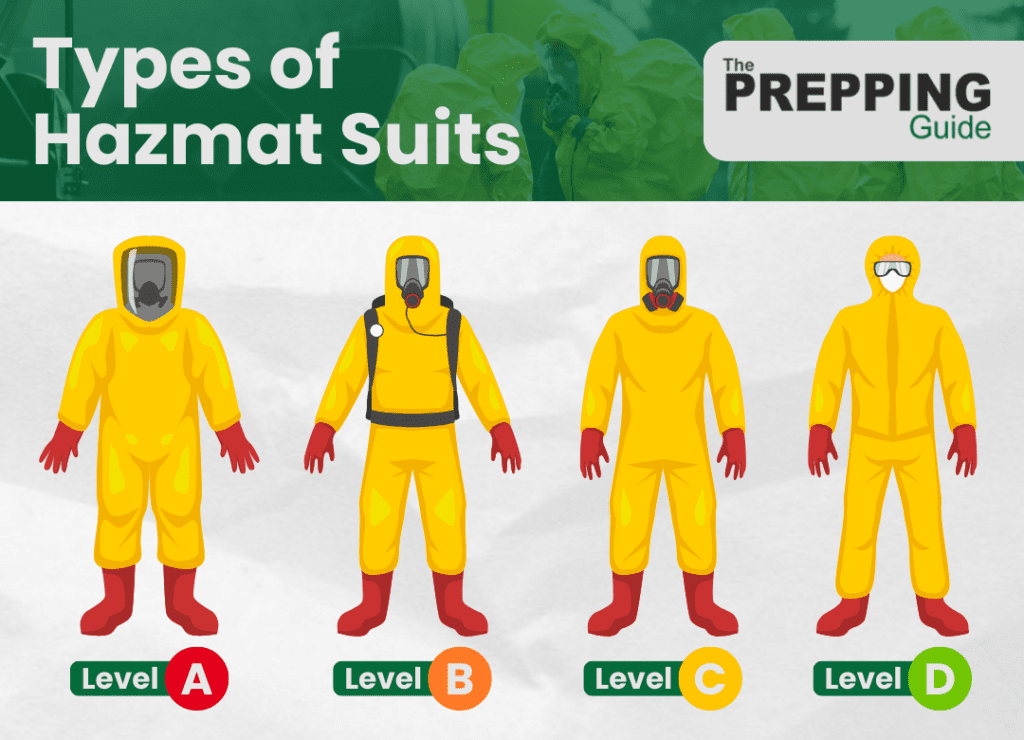
Here’s a breakdown of each level:
Level A
Level A suits offer the highest level of protection. They are gas-tight, featuring a positive pressurized oxygen tank and a full respirator. These suits are also equipped with chemical-resistant layers, making them ideal for environments with high concentrations of hazardous materials or where there is a risk of exposure to dangerous gases and vapors.
Application: Best used in situations where there is a high risk of exposure to toxic substances, and the highest level of skin, respiratory, and eye protection is required.
Level B
Level B hazmat suits are less protective than Level A but still offer significant protection. They are not gas-tight and are typically used with a positive pressure respirator. These suits primarily protect against chemical splashes, rather than gases or vapors.
Application: Suitable for scenarios where the air is breathable (no harmful vapors or gases) but there is still a risk of exposure to harmful liquids or particulate matter.
Level C
Level C suits provide protection against hazardous materials, but they are not gas-tight. They typically use a gas mask or an air-purifying respirator, rather than a self-contained breathing apparatus. Level C suits are less protective than Level B.
Application: Ideal for situations where the type and concentration of airborne substances are known and the air is safe to breathe, but there is still a risk of contamination.
Level D
Level D offers the least protection among all the hazmat suit levels. These suits generally consist of basic personal protective equipment, like aprons and goggles, and are used in environments with minimal hazard exposure.
Application: Best suited for situations where there is no respiratory hazard or major risk of skin exposure to hazardous chemicals.
Each level is designed to provide a specific type of protection, making it essential to choose the right suit based on the anticipated hazards in your environment.
Here’s a recap of the different levels of hazmat suits:
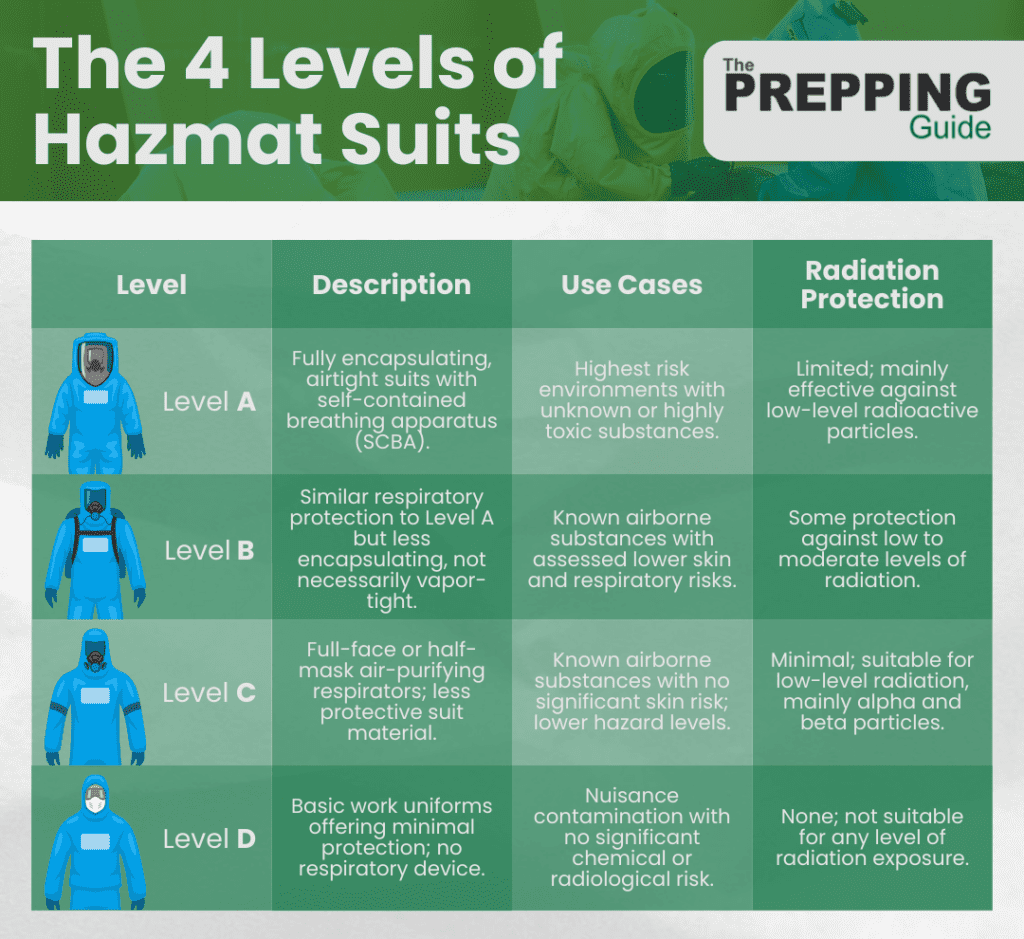
Factors Influencing Radiation Protection in Hazmat Suits
The effectiveness of hazmat suits in protecting against radiation depends on various factors. Understanding these can be crucial for effective protection in radiation-prone environments.
Material Composition
The materials used in hazmat suits are a primary factor in their protective capabilities. Suits may include lead, boron, or other heavy elements for their radiation-attenuating properties. The protection level is also influenced by the thickness of these materials and how they are layered within the suit’s design.
Here’s an overview of the different materials used in hazmat suits and how much they can protect you against radiation:
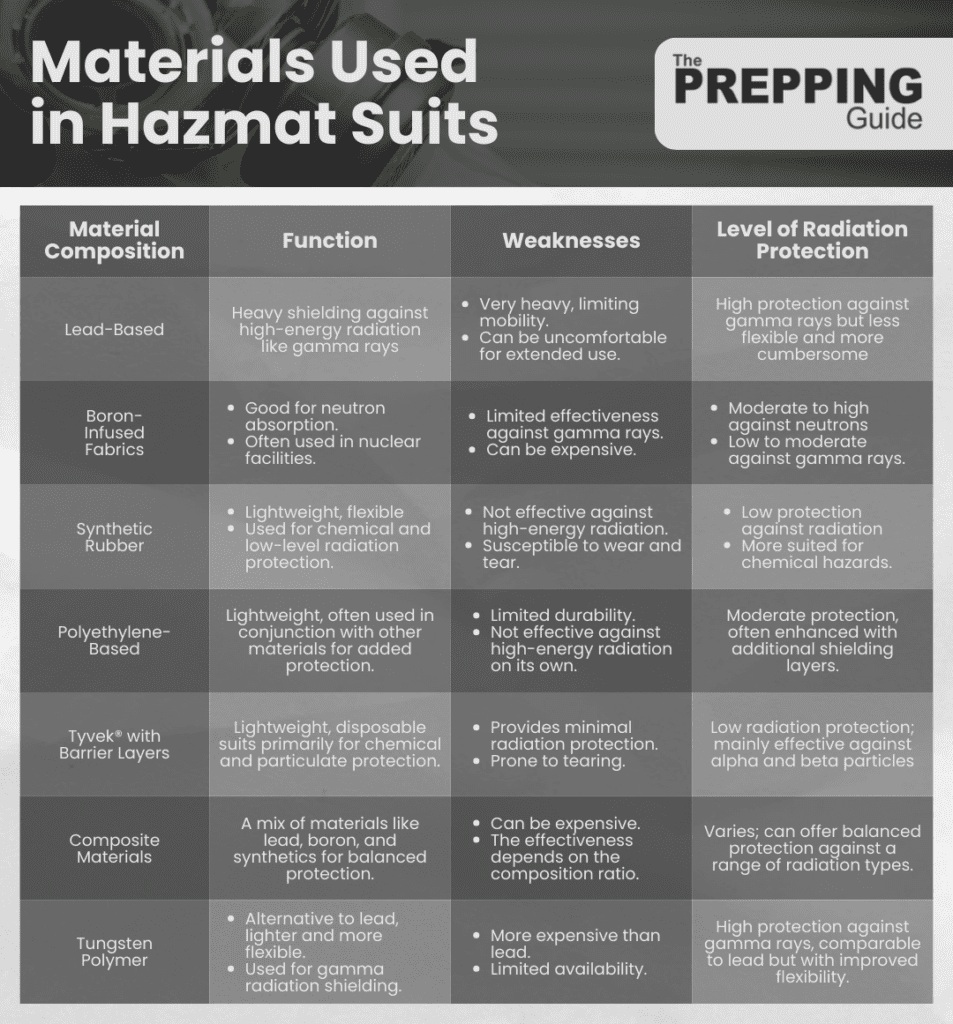
Design and Coverage
The overall design of the suit, especially at seams and joints, is critical, as these can be potential weak points for radiation penetration. Full body coverage, including head, hands, and feet, is essential for comprehensive protection.
Type of Radiation
Hazmat suits offer varying degrees of protection against different types of radiation, as shown in the table. They are generally more effective against alpha and beta particles, which can be blocked by lighter materials, but less effective against high-energy radiation like gamma rays or neutrons.
Radiation Exposure Limits of Hazmat Suits
While hazmat suits are a key component in radiation protection strategies, it’s important to recognize their limitations and the necessary considerations for their effective use.
Inherent Limitations of Hazmat Suits
Hazmat suits are designed to reduce, not completely eliminate, exposure to radiation. They are more effective against certain types of radiation (like alpha and beta particles) but offer limited protection against high-energy radiation such as gamma rays and neutrons.
The materials used in hazmat suits, while protective, have limits in their shielding capabilities. For instance, materials effective against lower-energy radiation might not shield effectively against high-energy radiation.
Over time, the protective materials in hazmat suits can degrade, especially under harsh conditions or after prolonged use. This degradation can reduce the suit’s effectiveness in shielding radiation.
Operational Considerations
The effectiveness of a hazmat suit is heavily dependent on proper fit and usage. A suit that is too loose or improperly worn can expose the wearer to radiation, negating its protective benefits.
Users of hazmat suits must be adequately trained in their correct use, including how to put them on (donning), take them off (doffing), and how to recognize signs of wear or damage.
Regular maintenance and inspection are also crucial to ensure the suits remain in good condition and provide the expected level of protection. This includes checking for tears, seam integrity, and material degradation.
Monitoring Radiation Exposure: The Role of Dosimeters in Safety
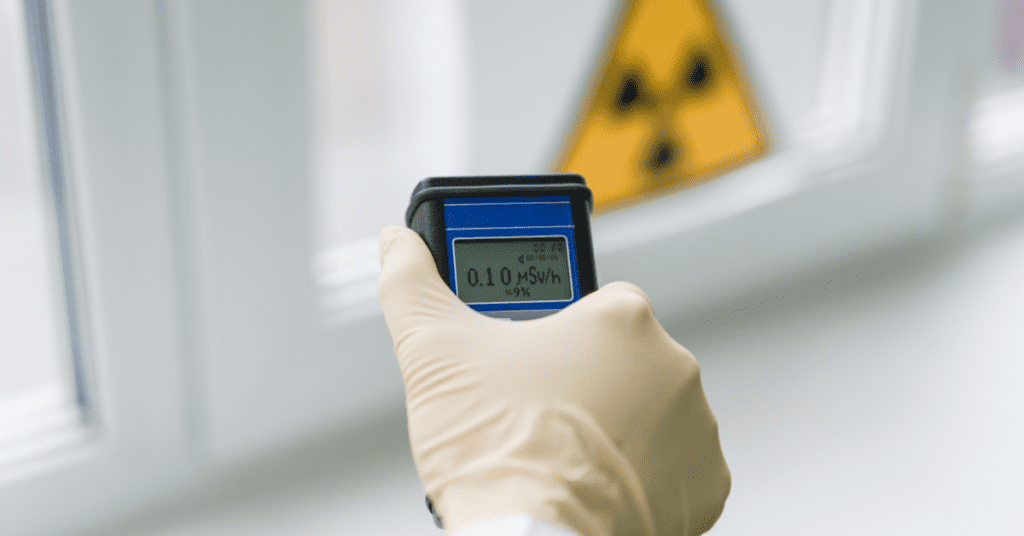
In addition to the protective features of hazmat suits, the use of personal radiation dosimeters plays a vital role in safety. These devices monitor the level of radiation exposure in real-time, alerting the wearer to dangerous levels of radiation.
They are an essential tool for anyone wearing a hazmat suit in potentially radioactive environments, providing an additional layer of safety by ensuring that exposure levels remain within safe limits. It’s a combination of the suit’s protective capabilities and the dosimeter’s monitoring that offers the most effective defense against radiation hazards.
Hazmat Suit Standards and Testing
International standards play a crucial role in defining the requirements for radiation protection in personal protective equipment (PPE). One such standard is the EN 1073-2:2002, which outlines the requirements and testing methods for non-ventilated protective clothing against particulate radioactive contamination. These standards ensure a uniform level of protection and quality across different manufacturers, making it easier for you to choose a suit that meets global safety benchmarks.
How Hazmat Suits are Tested for Radiation Protection
Hazmat suits undergo rigorous testing to ensure they meet the required standards for radiation protection. This testing involves exposing the suits to various forms of radiation and measuring their shielding effectiveness. The tests are designed to simulate real-world scenarios as closely as possible, ensuring that the suits can withstand the types of radiation they are likely to encounter in the field. This thorough testing process is critical for your safety, providing assurance that the suit you choose has been proven effective under stringent conditions.
Practical Considerations and Limitations
When considering hazmat suits for radiation protection, it’s not just about choosing the right suit; it’s also about understanding their practical limitations and applications. This understanding is key, whether you’re a professional working in hazardous environments or a prepper planning for potential emergencies.
Applying Hazmat Suits in Nuclear Facilities and Emergency Situations
In nuclear facilities and emergency scenarios, hazmat suits are a critical line of defense. They are designed to protect you from radioactive contamination, a constant threat in these environments. However, the level of protection varies depending on the suit’s design and the intensity of the radioactive exposure. It’s essential to choose a suit that aligns with the specific risks of the situation, whether it’s a controlled environment like a nuclear power plant or an unpredictable emergency scenario.
The use of hazmat suits in these settings is not just about personal safety; it’s also about preventing the spread of contamination. Your safety and the safety of others depend on the suit’s ability to contain contaminants and prevent them from being carried into clean areas. This is especially important in scenarios where radioactive materials might be dispersed in the environment, such as in the aftermath of a nuclear accident.
Recognizing the Boundaries of Fabric-Based Radiation Protection
Fabric-based suits are designed to prevent direct contact with radioactive particles but may not offer complete protection against high-energy, penetrating radiation like gamma rays. Understanding these boundaries helps you make informed decisions about the type of protective gear needed for specific radiation types.
When dealing with intense radiation sources, such as in a nuclear reactor, it’s vital to supplement fabric-based suits with additional protective measures. This might include lead aprons or shields in areas where high-energy radiation is present. Remember, no single piece of equipment can provide complete protection in all scenarios, so a combination of PPE tailored to the specific risk is often necessary.
Complementing Hazmat Suits with Essential Safety Accessories
To maximize protection, hazmat suits are often complemented with various safety accessories. Accessories like respirators, gloves, and protective footwear enhance the suit’s effectiveness by providing additional barriers against contamination. These accessories are especially crucial in scenarios where airborne particles or surface contamination pose a significant risk.
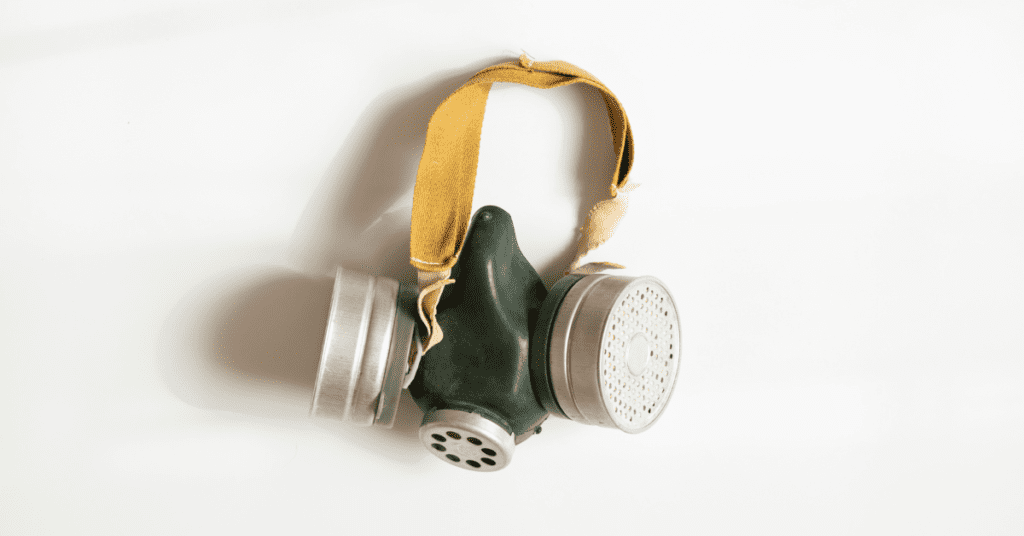
The choice of accessories should be based on the specific hazards you’re likely to encounter. For instance, in a scenario with a risk of inhaling radioactive particles, a high-efficiency particulate air (HEPA) filter respirator would be essential. Similarly, gloves and footwear should be chosen based on their ability to resist contamination and maintain their integrity in hazardous environments.
Addressing the Challenge of Secondary Radiation Exposure
Secondary radiation exposure, which occurs when radioactive particles contaminate surfaces or equipment, is a significant concern in hazardous environments. It’s a challenge that requires careful consideration, particularly in the context of suit disposal and decontamination procedures. After use in a contaminated area, the exterior of a hazmat suit can become a source of secondary exposure if not handled correctly.
To mitigate this risk, protocols for the safe removal and disposal of contaminated suits are essential. This includes procedures for carefully doffing the suit to avoid spreading contamination and guidelines for disposing of or decontaminating the suit safely. Adhering to these protocols is crucial for your safety and the safety of others in the area.
Key Factors to Consider When Choosing a Radiation-Protective Hazmat Suit
When selecting a hazmat suit for radiation protection, several key factors come into play. You need to consider the type and level of radiation you might encounter, the suit’s material and construction, and its compatibility with other protective gear. It’s also crucial to consider the environment in which you’ll be using the suit, such as temperature extremes, confined spaces, or the presence of other hazards like chemicals or biological agents.
Comfort and fit are important considerations, too. A suit that is too tight or restrictive can limit mobility and lead to fatigue, while an ill-fitting suit may not provide adequate protection. Additionally, the durability of the suit and its resistance to wear and tear in harsh environments are important factors to ensure long-term usability and safety.
Best Practices for Making Your Hazmat Suit More Effective
Adhering to best practices in training and protocol compliance for hazmat suit usage is not just about following rules; it’s a proactive approach to ensure safety in hazardous environments. Here is a list of best practices that are crucial for effective and safe use of hazmat suits:
Regular and Comprehensive Training
Engaging in regular and comprehensive training sessions is essential. This training should cover not only the basics of wearing and operating the suit but also specific protocols relevant to different hazardous scenarios.
Regular training keeps you prepared and confident in using the suit, especially under high-pressure situations where quick and accurate responses are vital.
Understanding Suit Limitations
Knowing the limitations of your hazmat suit, including its durability, resistance levels, and the types of hazards it can and cannot protect against, is crucial.
This knowledge enables you to make informed decisions about when and how to use the suit and what additional protective measures might be needed in certain scenarios.
Recognizing Signs of Suit Failure or Breach
Being able to identify signs of wear, tear, or breach in the suit can be life-saving. Regular checks before, during, and after use are necessary.
Early detection of any suit compromise allows for immediate action, either to repair or replace the suit, thereby maintaining continuous protection.
Here’s a list of signs of a hazmat suit breach:
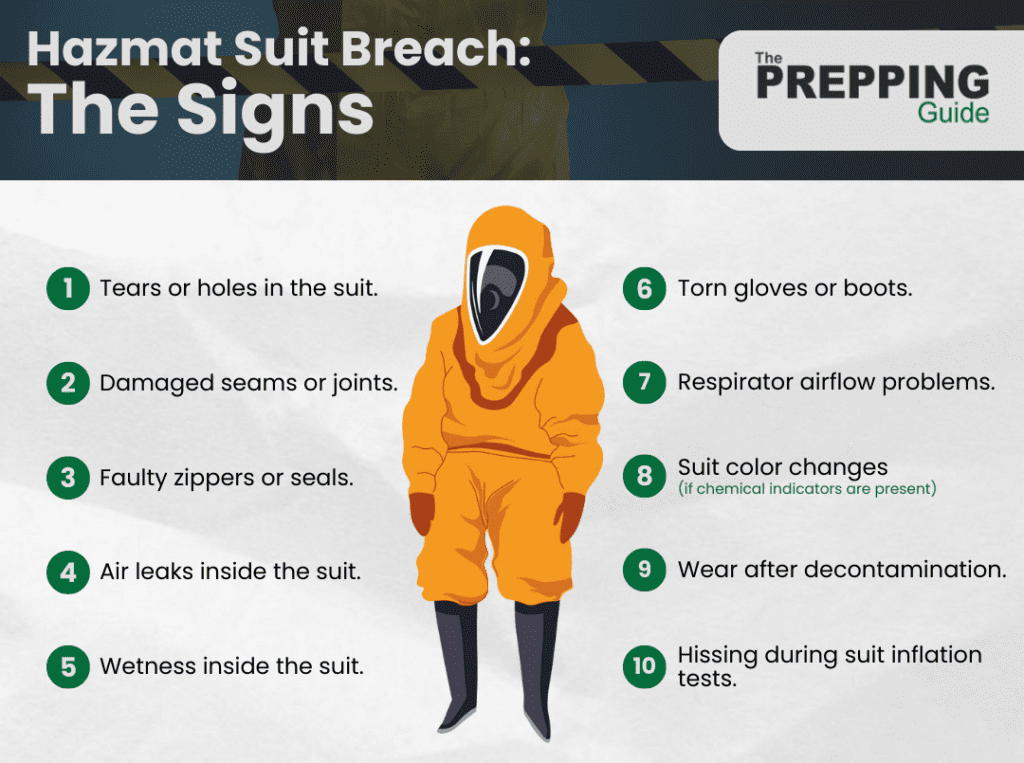
Participating in Emergency Response Drills
Engaging in regular emergency response drills, including simulations of hazardous scenarios, is crucial for preparing to use the suit in real-world situations.
These drills help in reinforcing training, improving response times, and ensuring calm and effective handling of emergencies.
Adherence to Industry Standards
Following industry standards and guidelines, which are based on extensive research and real-world experiences, ensures that the practices adopted are among the most effective and safe.
Compliance with these standards maximizes safety and effectiveness, as they are designed to cover a wide range of potential hazards and scenarios.
Continuous Learning and Adaptation
Staying informed about the latest advancements in hazmat suit technology and safety protocols is crucial. This involves continuous learning and adaptation of new practices.
The field of hazardous materials management is ever-evolving, and staying updated with the latest information ensures that you are always equipped with the best knowledge and tools for safety.
Final Thoughts
In conclusion, understanding the capabilities and limitations of hazmat suits, especially in terms of radiation protection, is essential for anyone working in hazardous environments or preparing for emergency situations. The effectiveness of a hazmat suit in protecting against radiation depends on various factors, including its material composition, design, and the type of radiation encountered.
Remember, no hazmat suit can provide complete immunity against all types of radiation. The key is to select the right suit for your specific needs, understand its limitations, and use it in conjunction with other safety practices and equipment. Regular training, proper donning and doffing procedures, effective decontamination, and suit disposal are all critical components of safe hazmat suit usage.
Whether you are a professional in a nuclear facility, a first responder in emergency situations, or a prepper planning for the unknown, your safety depends not just on the suit you wear but also on your knowledge, preparation, and adherence to safety protocols. Always stay informed, practice regularly, and prioritize safety in every aspect of your hazmat suit usage.
